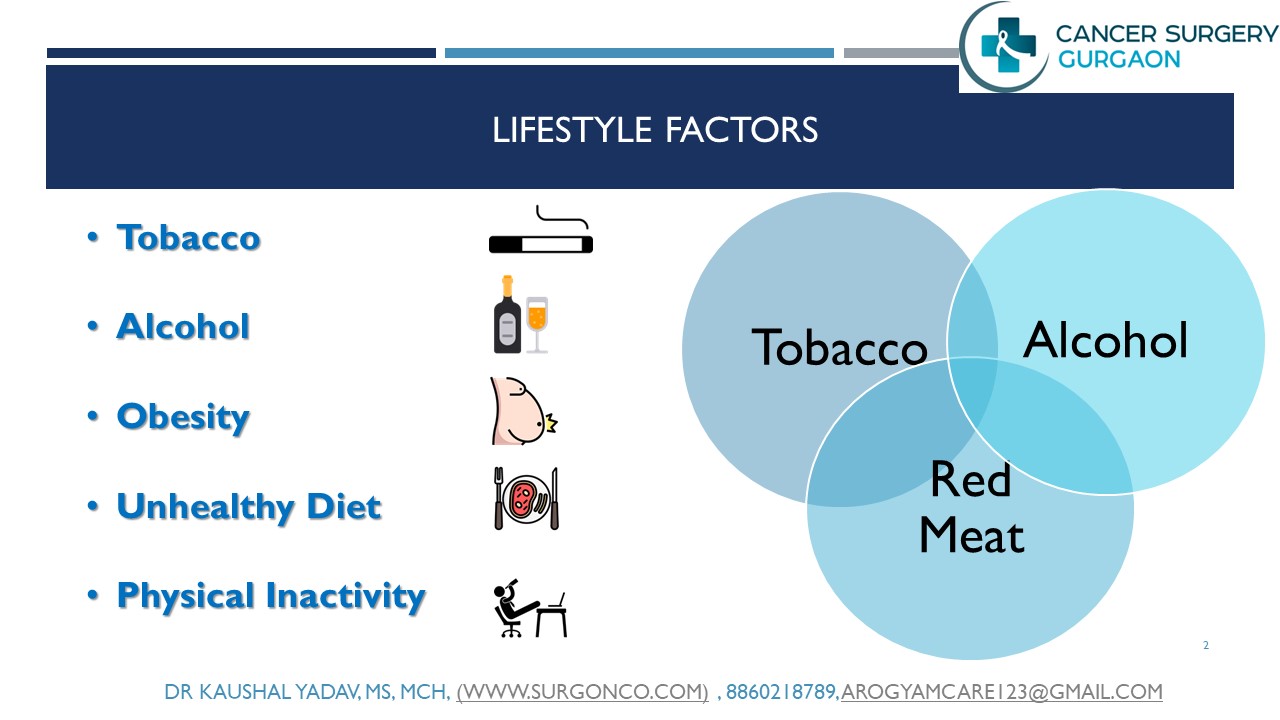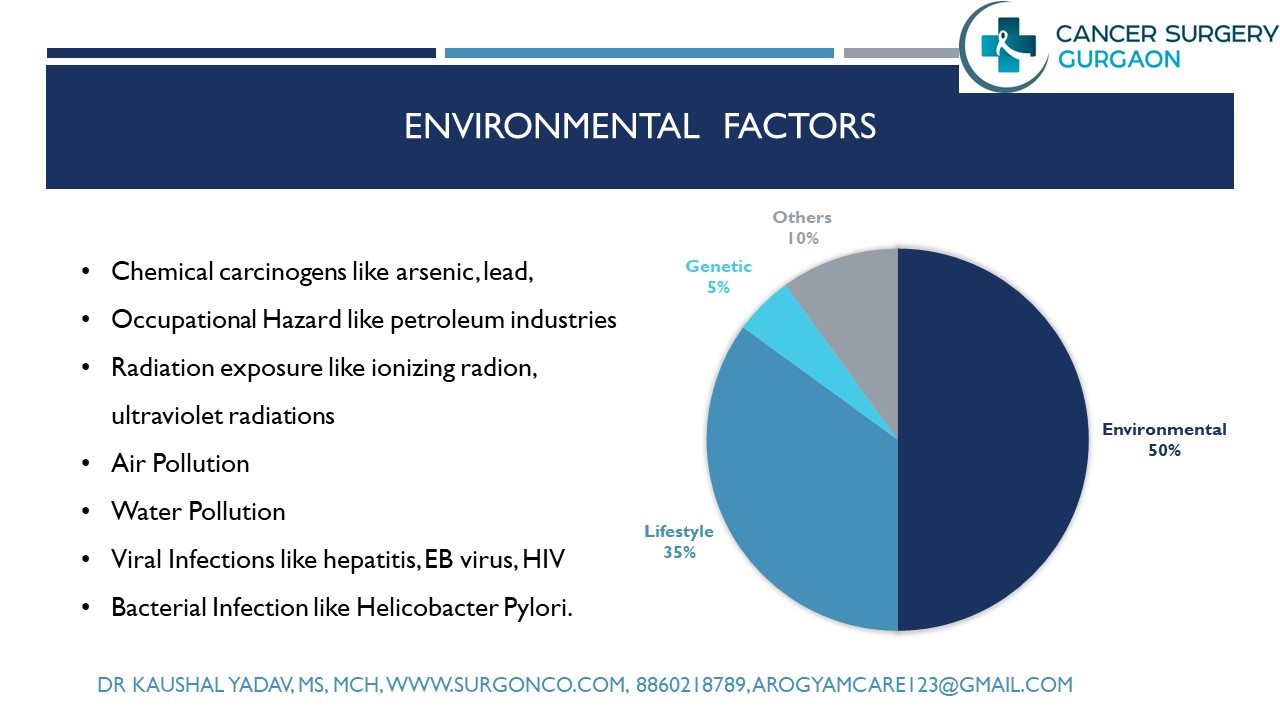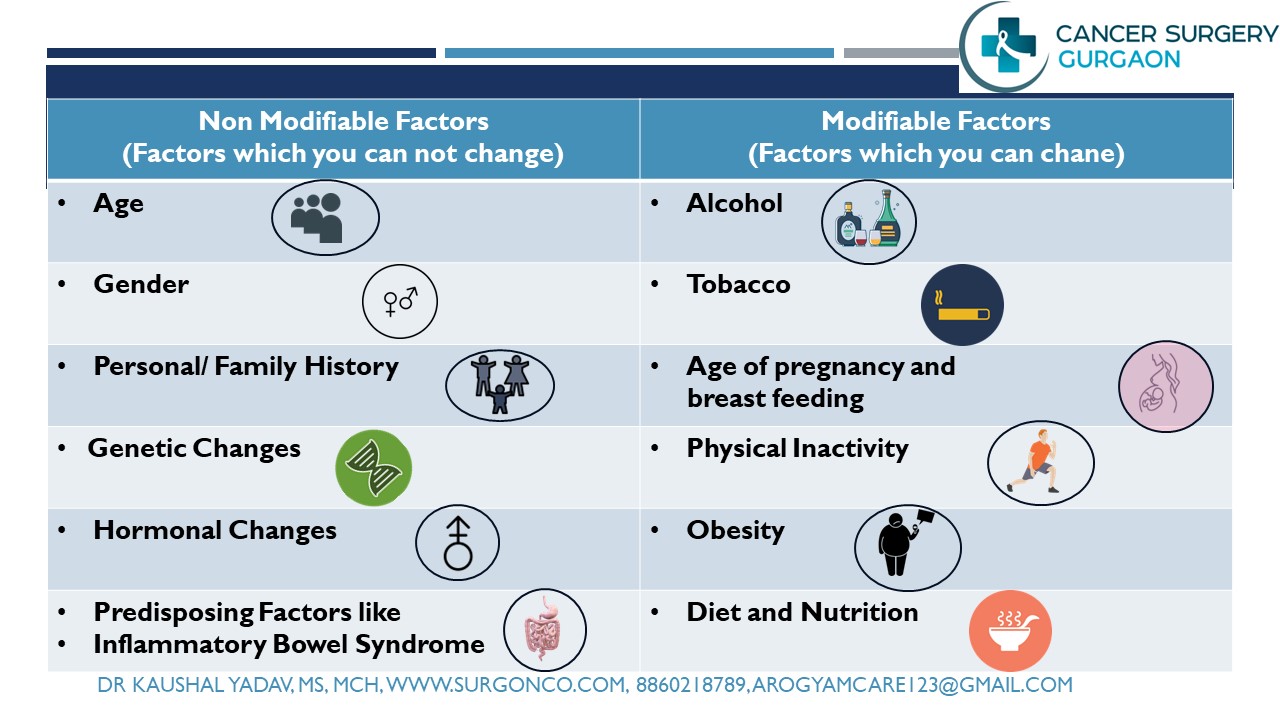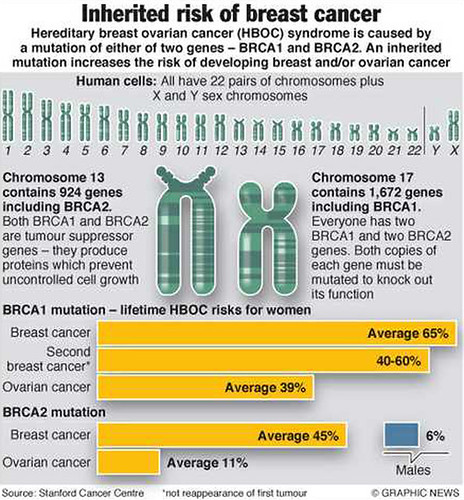
How does cancer occurs?
Cancer
Cancer is uncontrolled proliferation of transformed cells in any part of the body. Neoplasm or tumor are used variably to describe any swelling or new growth. Benign growths don’t have potential to spread to other organs or parts of the body while malignancy or malignant growths have uncontrolled proliferation and metastatic potential.
Transformation is multistep process with genetic alterations by which normal cells acquire malignant potential, uncontrolled proliferation capacity and capacity to spread to other parts of the body (metastasis)
01.
Lifestyle factors
- Tobacco consumption is responsible for 25% of preventable cancer related deaths.
- Alcohol increase risk of cancer with increase in amount of drinking.
- Obesity is associated with 15-20% of cancer related deaths.
- Unhealthy Diet- processed meats, red meats, excessive salt, excessive sugar and fat.
02.
Environmental Factors
- Air pollution is increasing cases of cancer.
- Radiation exposure from natural and artificial sources like ionizing radiation, Ultraviolet ray
- Chemical Carcinogens like asbestos, arsenic, teflon
- Infections like human papilloma virus, hepatitis, H. pylori, HIV
03.
Non Modifiable Factors
- Age >50 years : 60 % of cases and 70% of cancer related mortality occurs in this age group
- Gender: certain cancers are more common in females and others in male.
- Hormonal exposure: like estrogen excess for breast & endometrium cancer
- Certain conditions like inflammatory bowel disease
04.
Genetic Factors
- BRCA1 or BRCA2 genes mutation: increase the risk of breast and ovarian cancers.
- APC gene mutation: increase the risk of colon and rectum cancers.
- p53 mutation: increase the risk of several cancers.
Genetic testing can identify people who have these mutations and help them make informed decisions about prevention and treatment options.
Understanding Cancer: Causes, Types, and Treatment
Cancer is a complex group of diseases characterized by the uncontrolled growth and spread of abnormal cells in the body. If not treated, cancer can cause serious illness and death. However, advancements in medical science have significantly improved the understanding, prevention, and treatment of various types of cancer.
What is Cancer?
Cancer begins when cells in the body start to grow out of control. Normally, cells grow, divide, and die in an orderly fashion. However, cancer cells continue to grow and divide uncontrollably, forming tumors (masses of tissue) that can invade nearby tissues and spread to other parts of the body (a process known as metastasis).
Causes of Cancer
Cancer can be caused by a variety of factors, including:
Genetic Mutations: Changes in the DNA of cells can lead to cancer. These mutations can be inherited or acquired over time due to environmental factors.
Environmental Factors: Exposure to certain chemicals, radiation, and harmful substances, such as tobacco smoke, can increase the risk of cancer.
Lifestyle Factors: Unhealthy behaviors such as poor diet, lack of physical activity, excessive alcohol consumption, and tobacco use are major risk factors for cancer.
Infections: Certain viruses, bacteria, and parasites are linked to an increased risk of cancer. For example, human papillomavirus (HPV) is associated with cervical cancer, and hepatitis B and C viruses are linked to liver cancer.
Chronic Inflammation: Long-term inflammation in the body, often due to infections or autoimmune diseases, can contribute to the development of cancer.
Types of Cancer
There are over 100 different types of cancer, each classified based on the type of cell that is initially affected. Some of the most common types include:
Carcinomas: These cancers originate in the epithelial cells that line the internal organs and skin. Examples include breast, lung, prostate, and colorectal cancers.
Sarcomas: Sarcomas develop in connective tissues such as bones, muscles, and fat. Osteosarcoma (bone cancer) is a common type of sarcoma.
Leukemias: Leukemia is a type of cancer that affects the blood and bone marrow, where blood cells are produced. It usually does not form solid tumors but involves large numbers of abnormal white blood cells.
Lymphomas: Lymphoma is a cancer of the lymphatic system, which is part of the body’s immune system. Hodgkin lymphoma and non-Hodgkin lymphoma are the two main types.
Melanomas: Melanoma is a type of skin cancer that arises from melanocytes, the cells responsible for producing the pigment melanin.
Central Nervous System Cancers: These cancers affect the brain and spinal cord, with gliomas and meningiomas being common types.
Symptoms of Cancer
Cancer symptoms vary depending on the type, location, and stage of the disease. Common symptoms include:
- Unexplained Weight Loss: Sudden and unintentional weight loss can be an early sign of cancer.
- Fatigue: Persistent and unexplained fatigue that doesn’t improve with rest can indicate an underlying problem.
- Pain: Chronic pain in specific areas of the body may be associated with certain cancers, such as bone cancer.
- Changes in Skin: Unexplained changes in the skin, such as new moles, sores that don’t heal, or yellowing of the skin (jaundice), can be symptoms of cancer.
- Lumps or Masses: The presence of unusual lumps or swelling in the body can indicate a tumor.
- Persistent Cough or Hoarseness: A long-lasting cough or hoarseness can be a sign of lung or throat cancer.
- Changes in Bowel or Bladder Habits: Persistent constipation, diarrhea, or changes in the frequency of urination can be symptoms of colon, bladder, or prostate cancer.
Diagnosis and Staging
If cancer is suspected, a variety of diagnostic tests may be performed to confirm the diagnosis and determine the stage of the cancer. These tests can include:
- Imaging Tests: X-rays, CT scans, MRI, PET scans, and ultrasounds help visualize tumors and assess their size and spread.
- Biopsies: A sample of tissue is taken from the suspected area and examined under a microscope to detect cancer cells.
- Blood Tests: Certain cancers can be detected by analyzing blood for specific markers or abnormal levels of substances.
- Endoscopy: A flexible tube with a camera is used to examine internal organs and obtain tissue samples.
The stage of cancer indicates how far it has spread. Staging helps guide treatment decisions and predict the likely course of the disease. Stages range from I (localized) to IV (advanced, with metastasis).
Treatment of Cancer
Treatment for cancer varies based on the type, stage, and location of the cancer, as well as the patient’s overall health. Common treatment options include:
Surgery: The removal of cancerous tissue through surgery is often the first line of treatment for solid tumors.
Radiation Therapy: High-energy rays or particles are used to target and destroy cancer cells. Radiation therapy can be used alone or in combination with other treatments.
Chemotherapy: Chemotherapy uses drugs to kill rapidly dividing cancer cells throughout the body. It is often used to treat cancers that have spread or to shrink tumors before surgery.
Targeted Therapy: This treatment targets specific molecules involved in cancer growth, often with fewer side effects than traditional chemotherapy.
Immunotherapy: Immunotherapy boosts the body’s immune system to recognize and attack cancer cells.
Hormone Therapy: Used for cancers that are influenced by hormones, such as breast and prostate cancers. Hormone therapy blocks or reduces hormone production to slow the growth of cancer cells.
Stem Cell Transplant: Also known as bone marrow transplant, this procedure replaces damaged or destroyed bone marrow with healthy stem cells, often used in the treatment of blood cancers like leukemia.
Prevention and Early Detection
While not all cancers can be prevented, certain lifestyle changes can significantly reduce the risk. These include:
- Avoiding Tobacco: Smoking is a major risk factor for many types of cancer.
- Healthy Diet: A diet rich in fruits, vegetables, whole grains, and lean proteins can lower the risk of cancer.
- Regular Exercise: Physical activity helps maintain a healthy weight and reduces the risk of various cancers.
- Limiting Alcohol Consumption: Excessive alcohol intake is linked to an increased risk of several cancers.
- Sun Protection: Protecting skin from excessive sun exposure reduces the risk of skin cancer, including melanoma.
- Vaccination: Vaccines like HPV and hepatitis B can prevent infections that lead to certain cancers.
- Regular Screenings: Early detection through screenings such as mammograms, colonoscopies, and Pap smears can detect cancer in its early stages, when it is most treatable.
Living with Cancer
A cancer diagnosis can be life-altering, but support and resources are available to help patients and their families cope with the challenges. This includes:
- Emotional and Psychological Support: Counseling, support groups, and mental health services can help patients manage the emotional impact of cancer.
- Palliative Care: Focuses on relieving symptoms and improving the quality of life for patients with advanced cancer.
- Nutritional Support: Proper nutrition is crucial for maintaining strength and supporting the body during treatment.
- Rehabilitation: Physical therapy and rehabilitation services can help patients recover strength and function after treatment.
Conclusion
Cancer is a major health challenge worldwide, but ongoing research and advances in treatment continue to improve outcomes for patients. Understanding the causes, recognizing the symptoms, and seeking early treatment are key to managing cancer effectively. By making healthy lifestyle choices and staying informed about preventive measures and treatment options, individuals can reduce their risk and improve their chances of successful treatment if diagnosed.






